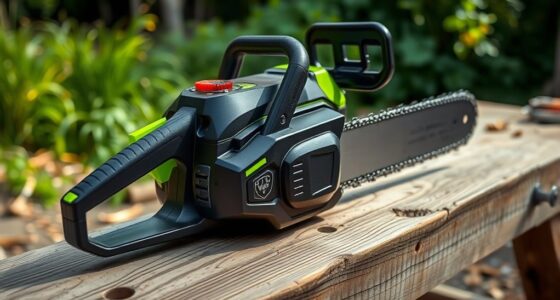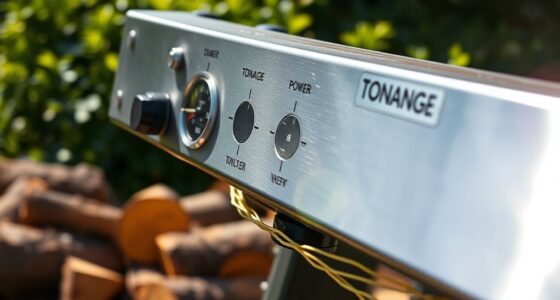When choosing between cross-cutting and rip-cutting firewood, consider your goals. Cross-cutting slices logs perpendicular to the grain, creating short, manageable pieces ideal for drying and handling, while rip-cutting cuts along the grain for precise, uniform logs that fit specific stoves or fire pits. Each method offers benefits for safety, efficiency, and reducing waste. To optimize your firewood process, understanding when and how to use these techniques can make a big difference.
Key Takeaways
- Cross-cutting slices perpendicular to the grain, producing short, manageable pieces, ideal for drying and quick seasoning.
- Rip-cutting follows the grain, creating uniform, precise lengths, suitable for fitting wood into stoves or reducing waste.
- Cross-cutting offers easier handling and reduces slip risks, while rip-cutting enhances stacking and organization.
- Cross-cutting exposes more surface area for faster drying, whereas rip-cutting minimizes waste and improves size control.
- Use cross-cutting for shorter logs and quick seasoning; employ rip-cutting for precise sizing and efficient stacking.
Understanding the Basic Differences Between Cross-Cutting and Rip-Cutting
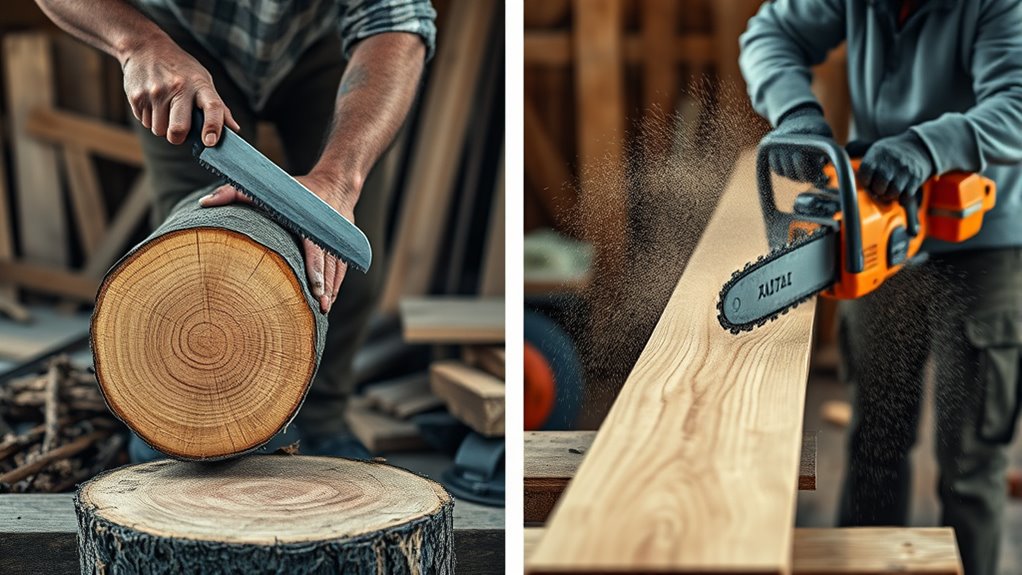
To understand the basic differences between cross-cutting and rip-cutting, it’s important to recognize that each technique serves a distinct purpose in cutting firewood. Cross-cutting involves slicing through the wood perpendicular to the grain orientation, which requires precise control of cutting angles to produce clean, even ends. This method is ideal for making shorter logs or preparing wood for burning. Rip-cutting, on the other hand, follows the grain direction, cutting parallel to it. This process demands careful attention to cutting angles that align with the grain, helping you split large logs into manageable sections. Knowing how grain orientation affects your cuts makes it easier to choose the right technique, ensuring efficiency and minimizing damage to your tools. Additionally, understanding how grain orientation impacts your cuts can significantly improve your efficiency and the quality of your firewood. Recognizing the grain structure of the wood can also influence how you approach each cut for optimal results.
Tools and Techniques for Cross-Cutting and Rip-Cutting

Choosing the right tools and techniques is essential for effective cross-cutting and rip-cutting. For cross-cutting, a chainsaw with a fine-tooth chain provides clean, precise cuts through logs. It’s fast and efficient, especially for larger pieces. When working with smaller logs or more control, a hand axe can help you make quick, accurate cuts, though it requires more effort and skill. For rip-cutting, a chainsaw equipped with a ripping chain or a chainsaw mill helps you cut along the wood’s grain, creating even boards. Alternatively, a handsaw or a circular saw can work for smaller projects or thinner wood. Always make sure your tools are sharp and properly maintained to maximize safety and cutting precision. Proper technique and the right tools make your firewood preparation safer and more efficient. Additionally, selecting the appropriate saw blade ensures smoother cuts and reduces the risk of kickback during operation. To further improve your cutting accuracy, understanding the Kia Tuning concepts can inspire the use of specialized equipment for custom modifications and precision work.
Advantages of Cross-Cutting in Firewood Preparation
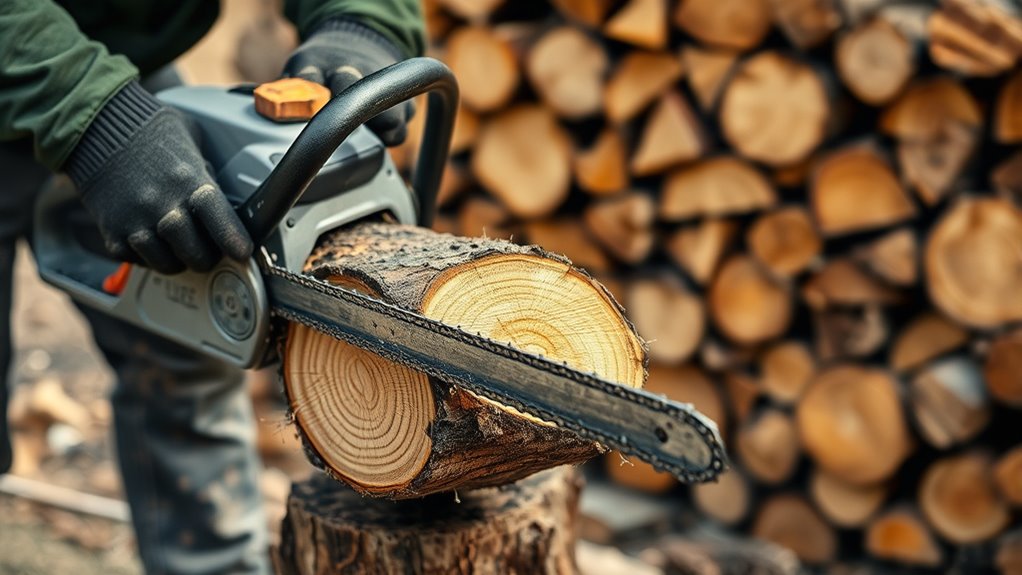
Cross-cutting makes handling logs much easier because the cuts are more manageable. It also promotes safer cutting since you’re less likely to lose control of the saw or blade. Overall, this method simplifies firewood preparation and reduces the risk of accidents. Additionally, proper appliance maintenance during preparation can ensure tools remain in good condition, enhancing safety and efficiency.
Easier to Handle Logs
Handling logs becomes much easier when they’re cross-cut, as smaller, more manageable pieces allow you to lift, move, and position them with less effort. Cross-cut logs typically have better log stability, reducing the risk of slipping or rolling during handling. This stability makes stacking and stacking safer and more efficient. Additionally, cross-cutting exposes different wood grain directions, making it easier to grip and handle logs regardless of wood density. Heavier, denser woods become more manageable because smaller cross-cut pieces require less strength to lift and transport. Proper log handling techniques are essential for maintaining safety and efficiency during firewood processing. Moreover, cross-cutting can improve cutting precision, making subsequent splitting or further processing easier and more effective. Using the right tools and techniques can also help verify the authenticity of equipment, ensuring safety and durability during your work. Incorporating safety precautions when handling logs further reduces the risk of accidents and injuries during firewood preparation.
Promotes Safer Cutting
By making smaller, more manageable logs through cross-cutting, you considerably reduce the risks associated with firewood preparation. This method enhances fire safety by decreasing the chance of logs slipping or pinching the saw, which can lead to accidents. It also promotes proper equipment maintenance, as smaller cuts put less strain on your saw and blades, extending their lifespan. Plus, cross-cutting reduces the likelihood of kickbacks, keeping you safer during cuts. To maximize safety:
- Ensure your saw is well-maintained and sharp for precise cuts
- Use proper protective gear, like gloves and eye protection
- Keep your workspace clear of debris and distractions
These precautions, combined with cross-cutting, help create a safer environment and lower the risk of injury during firewood preparation.
Benefits of Rip-Cutting When Handling Firewood
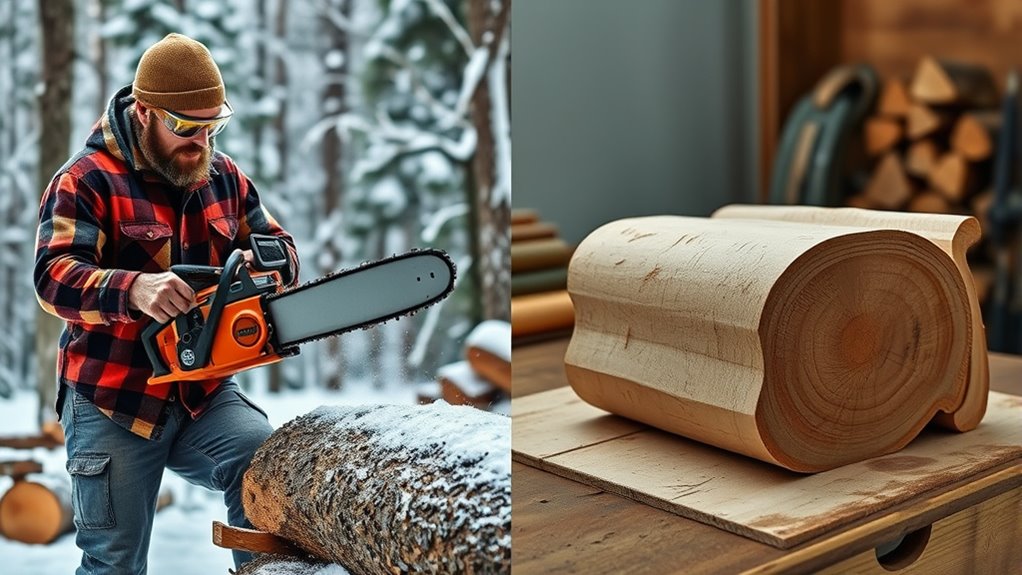
Rip-cutting allows you to control the size of your firewood with precision, making it easier to fit your fireplace or stove. It also reduces wood waste by producing uniform pieces, saving you time and effort. Plus, rip-cut logs are easier to stack neatly, keeping your firewood organized and accessible. Additionally, understanding the cost of various tools can help you choose the most efficient equipment for your needs. Using the right cutting techniques can further improve efficiency and safety during firewood preparation. Incorporating proper safety precautions ensures a safer and more effective workflow during cutting.
Precise Size Control
When you use rip-cutting techniques on firewood, you gain the ability to achieve precise size control. This allows you to customize your firewood to fit your stove or fireplace perfectly, reducing waste and increasing efficiency. To ensure clean cuts, focus on proper grip techniques that stabilize the wood and maintain control throughout the cut. Regular blade maintenance is essential; a sharp blade minimizes splintering and guarantees accurate, straight cuts. Additionally, paying attention to your technique helps you avoid uneven splits. Consider these factors for ideal results:
- Proper grip techniques for stability and control
- Regular blade maintenance for clean, accurate cuts
- Consistent pressure and straight-line guidance during the cut
- Proper technique ensures safety and efficiency when handling firewood. Improving your digital literacy can also enhance your overall safety and confidence when using power tools or handling equipment. Being aware of safety precautions is crucial to prevent accidents and injuries during cutting tasks. Understanding firewood sizing principles can further help you optimize your wood preparation for different heating systems. Incorporating visual guides like chalk lines or marking tapes can significantly improve cut accuracy and consistency.
Mastering these practices lets you produce firewood of the exact size you need effortlessly.
Less Wood Waste
Achieving precise cuts through rip-cutting not only improves size accuracy but also minimizes wood waste. When you cut firewood with rip cuts, you reduce the amount of unusable scraps left over, making the most of each log. This efficiency is especially helpful during log splitting, as you can tailor pieces to ideal sizes for seasoning. Less waste means you use fewer logs overall, saving you money and effort. Properly sized pieces also dry evenly, speeding up firewood seasoning. To illustrate, here’s a quick comparison:
| Rip-Cutting Benefits | Cross-Cutting Drawbacks |
|---|---|
| Less wood waste | More scraps from uneven cuts |
| Better for log splitting | Higher wood waste |
| Consistent sizing | Less precise size control |
| Faster firewood seasoning | Longer seasoning time |
Additionally, rip-cutting can help optimize the use of firewood processing tools and techniques, making your overall wood management more efficient. Incorporating precise cutting methods can further enhance your firewood preparation and reduce unnecessary waste.
Easier Stacking
Because firewood pieces are cut to uniform sizes with rip-cutting, stacking becomes much easier and more organized. Consistent dimensions help you maximize space and create stable stacks, reducing the risk of toppling. This uniformity also simplifies firewood seasoning, as evenly sized pieces dry more uniformly and efficiently. Additionally, rip-cutting makes tool maintenance simpler; smaller, consistent cuts put less strain on your tools, prolonging their lifespan. When stacking, you can easily align logs, improving airflow and reducing moisture buildup. Plus, organized stacks save time when fetching wood later, making your firewood handling more efficient overall. Rip-cutting’s precision ultimately results in a cleaner, safer, and more manageable firewood storage process. Moreover, understanding the importance of organized communication can help ensure safe and efficient handling of firewood tasks.
When to Choose Cross-Cutting Over Rip-Cutting and Vice Versa
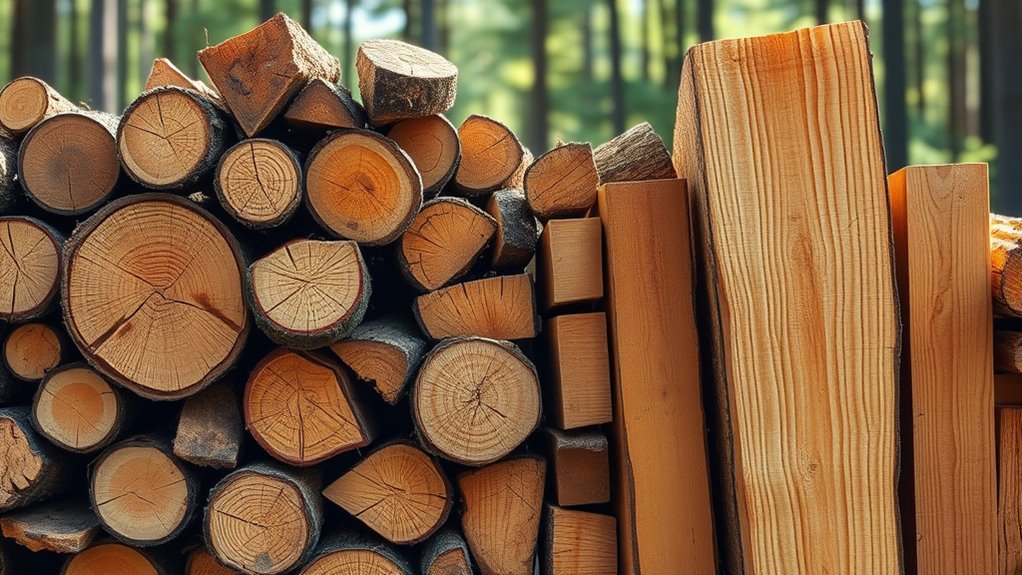
Choosing between cross-cutting and rip-cutting depends on the type of firewood you need and your specific goals. If you want firewood that dries quickly, cross-cutting is ideal because it exposes more surface area, promoting faster seasoning and reducing wood moisture content. Use cross-cutting when working with freshly cut logs that require rapid drying or when you need shorter pieces for a specific stove or fire pit. Rip-cutting, on the other hand, is better suited for creating longer, uniform logs from larger rounds, especially if you want to maximize wood volume. Consider the moisture content of your wood—drier wood burns more efficiently—and select your cutting method accordingly to improve fire performance and ease of handling.
Tips for Safe and Effective Cutting of Firewood
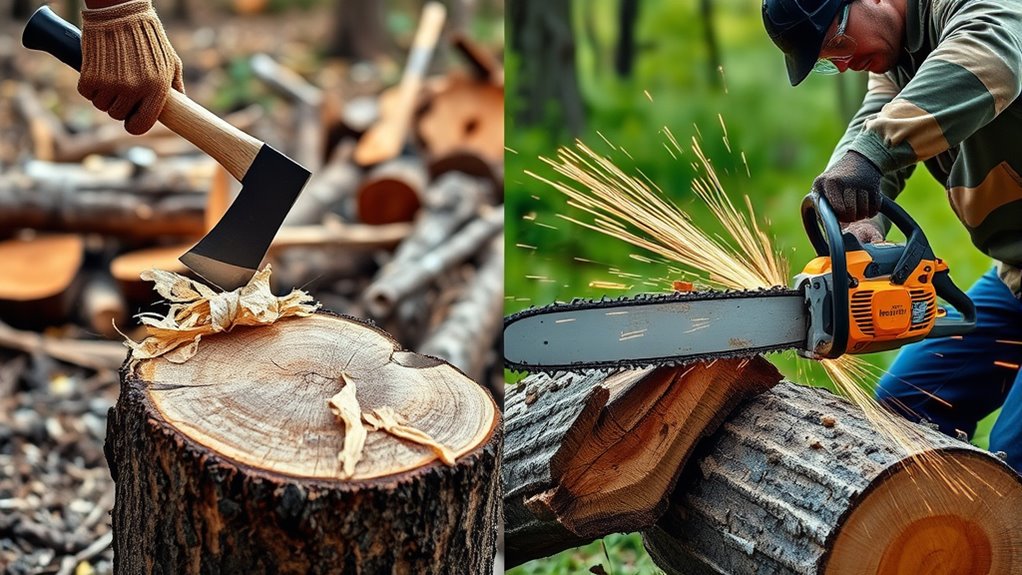
To cut firewood safely and effectively, always prioritize proper technique and the right tools. Use a sharp saw suited for the job, and secure the wood on a stable surface or sawhorses. When planning seasonal cutting, consider the best time to harvest, ensuring the wood is seasoned properly for better burning. Proper firewood storage helps keep your logs dry and reduces safety hazards.
To improve safety and efficiency:
- Wear protective gear like gloves and eye protection
- Keep your workspace clear of obstructions
- Cut from a stable position, avoiding overreaching or unstable footing
Frequently Asked Questions
Which Cutting Method Produces Smoother Firewood Surfaces?
You’ll find that the cutting method impacts the surface finish of your firewood. When you cut with the grain alignment in mind, the surface tends to be smoother because the cut follows the natural wood fibers. Cross-cutting, which cuts across the grain, often results in a rougher surface. So, for a smoother firewood surface, you should opt for a cut that respects the grain alignment, enhancing the surface finish.
How Does Wood Type Influence the Choice Between Cross and Rip Cuts?
Your choice between cross and rip cuts depends on wood type, especially considering wood density and grain orientation. Denser woods with straight grain are easier to rip cut, providing cleaner, more precise cuts. Conversely, woods with irregular grain may require cross cuts for smoother surfaces. So, understanding the wood’s properties helps you decide which cutting method yields better results, ensuring safer and more efficient firewood preparation.
Can Combining Both Cutting Techniques Improve Firewood Seasoning?
Combining both cutting techniques can definitely improve the seasoning process by reducing moisture content more effectively. When you cross-cut and rip-cut firewood, you increase surface area, allowing moisture to escape faster. This results in quicker drying and better seasoning. By using both methods, you guarantee the wood dries evenly and thoroughly, making it easier to burn and more efficient. So, yes, blending cutting techniques helps achieve ideal firewood seasoning.
What Are Common Mistakes to Avoid When Cross-Cutting or Rip-Cutting Firewood?
You’d think safety hazards and tool maintenance would be obvious concerns, but many overlook them. When cross-cutting or rip-cutting firewood, avoid rushing or using dull blades—they’re more dangerous and less effective. Keep tools sharp, well-maintained, and always wear safety gear. Ignoring these basics risks accidents and damages your tools. Ironically, paying attention to safety hazards and maintaining tools ensures smoother cuts and safer fires—so don’t neglect these vital steps.
How Do Cutting Techniques Affect Firewood Burn Efficiency?
Your cutting technique directly impacts firewood burn efficiency by affecting moisture retention and wood splitting. When you cut with precision, you reduce the wood’s surface area exposed to air, helping it dry faster and burn more efficiently. Proper cuts also facilitate better wood splitting, creating uniform pieces that ignite easily. Avoid rough cuts that trap moisture or cause uneven splits, as these issues hinder combustion and lead to inefficient, smoky fires.
Conclusion
So, now you’re officially an expert in firewood slicing—congratulations! Whether you choose cross-cutting or rip-cutting, just remember: safety first, unless you enjoy the thrill of a surprise splinter or a misaligned cut. With the right tools and a little patience, you’ll master the art of firewood prep faster than you can say “splinters galore.” Happy chopping—may your firewood be ever straight, and your cuts always perfectly imperfect!


